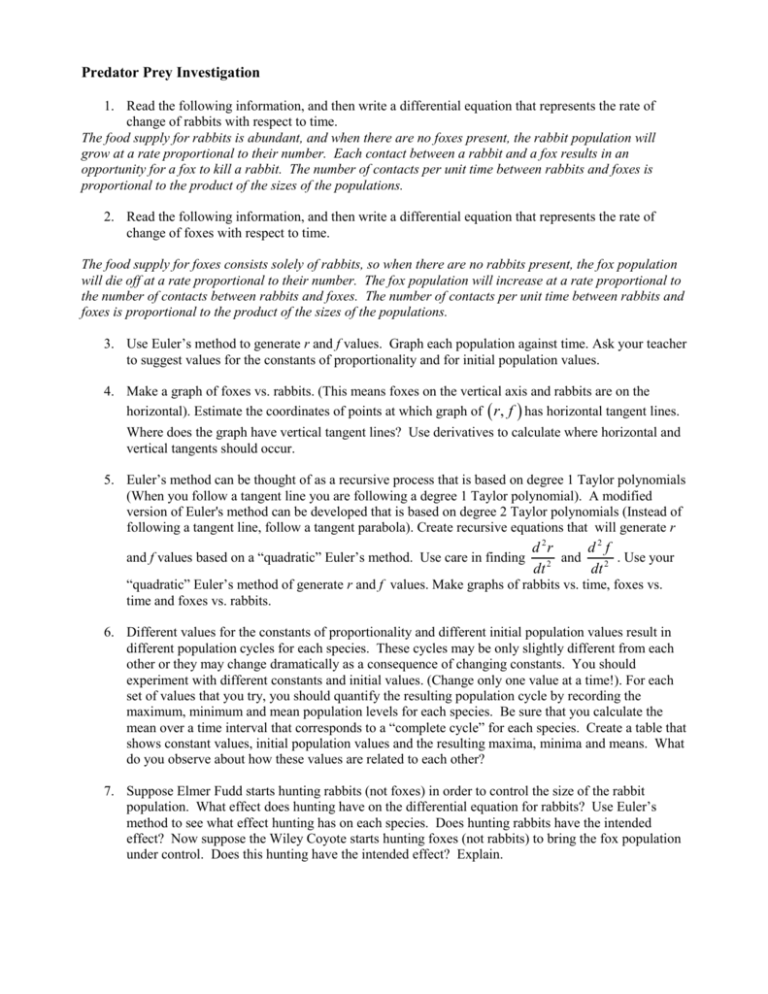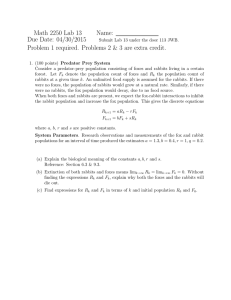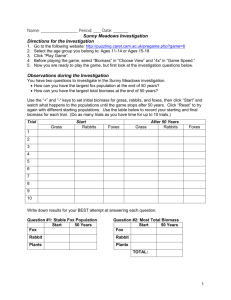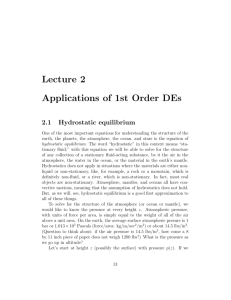Predator Prey lab
advertisement

Predator Prey Investigation 1. Read the following information, and then write a differential equation that represents the rate of change of rabbits with respect to time. The food supply for rabbits is abundant, and when there are no foxes present, the rabbit population will grow at a rate proportional to their number. Each contact between a rabbit and a fox results in an opportunity for a fox to kill a rabbit. The number of contacts per unit time between rabbits and foxes is proportional to the product of the sizes of the populations. 2. Read the following information, and then write a differential equation that represents the rate of change of foxes with respect to time. The food supply for foxes consists solely of rabbits, so when there are no rabbits present, the fox population will die off at a rate proportional to their number. The fox population will increase at a rate proportional to the number of contacts between rabbits and foxes. The number of contacts per unit time between rabbits and foxes is proportional to the product of the sizes of the populations. 3. Use Euler’s method to generate r and f values. Graph each population against time. Ask your teacher to suggest values for the constants of proportionality and for initial population values. 4. Make a graph of foxes vs. rabbits. (This means foxes on the vertical axis and rabbits are on the horizontal). Estimate the coordinates of points at which graph of r , f has horizontal tangent lines. Where does the graph have vertical tangent lines? Use derivatives to calculate where horizontal and vertical tangents should occur. 5. Euler’s method can be thought of as a recursive process that is based on degree 1 Taylor polynomials (When you follow a tangent line you are following a degree 1 Taylor polynomial). A modified version of Euler's method can be developed that is based on degree 2 Taylor polynomials (Instead of following a tangent line, follow a tangent parabola). Create recursive equations that will generate r and f values based on a “quadratic” Euler’s method. Use care in finding d 2r d2 f and . Use your dt 2 dt 2 “quadratic” Euler’s method of generate r and f values. Make graphs of rabbits vs. time, foxes vs. time and foxes vs. rabbits. 6. Different values for the constants of proportionality and different initial population values result in different population cycles for each species. These cycles may be only slightly different from each other or they may change dramatically as a consequence of changing constants. You should experiment with different constants and initial values. (Change only one value at a time!). For each set of values that you try, you should quantify the resulting population cycle by recording the maximum, minimum and mean population levels for each species. Be sure that you calculate the mean over a time interval that corresponds to a “complete cycle” for each species. Create a table that shows constant values, initial population values and the resulting maxima, minima and means. What do you observe about how these values are related to each other? 7. Suppose Elmer Fudd starts hunting rabbits (not foxes) in order to control the size of the rabbit population. What effect does hunting have on the differential equation for rabbits? Use Euler’s method to see what effect hunting has on each species. Does hunting rabbits have the intended effect? Now suppose the Wiley Coyote starts hunting foxes (not rabbits) to bring the fox population under control. Does this hunting have the intended effect? Explain.







